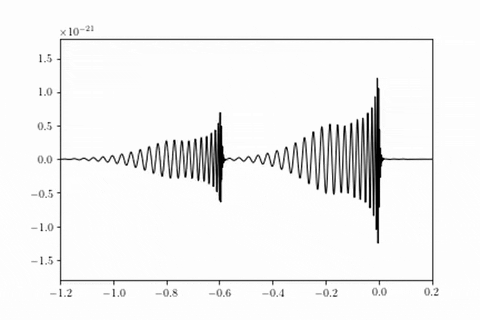
There's something a little off about our theory of the universe. Almost everything fits, but there's a fly in the cosmic ointment, a particle of sand in the infinite sandwich. Some scientists think the culprit might be gravity—and that subtle ripples in the fabric of space-time could help us find the missing piece.
A new paper co-authored by a University of Chicago scientist lays out how this might work. Published Dec. 21 in Physical Review D, the method depends on finding such ripples that have been bent by traveling through supermassive black holes or large galaxies on their way to Earth.
The trouble is that something is making the universe not only expand, but expand faster and faster over time—and no one knows what it is. (The search for the exact rate is an ongoing debate in cosmology).
Scientists have proposed all kinds of theories for what the missing piece might be. "Many of these rely on changing the way gravity works over large scales," said paper co-author Jose María Ezquiaga, a NASA Einstein postdoctoral fellow in the Kavli Institute for Cosmological Physics at the UChicago. "So gravitational waves are the perfect messenger to see these possible modifications of gravity, if they exist."
Gravitational waves are ripples in the fabric of space-time itself; since 2015, humanity has been able to pick up these ripples using the LIGO observatories. Whenever two massively heavy objects collide elsewhere in the universe, they create a ripple that travels across space, carrying the signature of whatever made it—perhaps two black holes or two neutron stars colliding.
In the paper, Ezquiaga and co-author Miguel Zumalácarregui argue that if such waves hit a supermassive black hole or cluster of galaxies on their way to Earth, the signature of the ripple would change. If there were a difference in gravity compared to Einstein's theory, the evidence would be embedded in that signature.
For example, one theory for the missing piece of the universe is the existence of an extra particle. Such a particle would, among other effects, generate a kind of background or "medium" around large objects. If a traveling gravitational wave hit a supermassive black hole, it would generate waves that would get mixed up with the gravitational wave itself. Depending on what it encountered, the gravitational wave signature could carry an "echo," or show up scrambled.
"This is a new way to probe scenarios that couldn't be tested before," Ezquiaga said.
Their paper lays out the conditions for how to find such effects in future data. The next LIGO run is scheduled to begin in 2022, with an upgrade to make the detectors even more sensitive than they already are.
"In our last observing run with LIGO, we were seeing a new gravitational wave reading every six days, which is amazing. But in the entire universe, we think they're actually happening once every five minutes," Ezquiaga said. "In the next upgrade, we could see so many of those—hundreds of events per year."
The increased numbers, he said, make it more likely that one or more wave will have traveled through a massive object, and that scientists will be able to analyze them for clues to the missing components.
Zumalácarregui, the other author on the paper, is a scientist at the Max Planck Institute for Gravitational Physics in Germany as well as the Berkeley Center for Cosmological Physics at Lawrence Berkeley National Laboratory and the University of California, Berkeley.
Explore further
Citation: Ripples in space-time could provide clues to missing components of the universe (2020, December 28) retrieved 28 December 2020 from https://ift.tt/37RWqC5
This document is subject to copyright. Apart from any fair dealing for the purpose of private study or research, no part may be reproduced without the written permission. The content is provided for information purposes only.
https://ift.tt/2MenH9G
Science
No comments:
Post a Comment